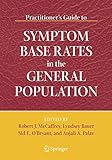Practitioner’s Guide to Symptom Base Rates in the General Population / edited by Robert J. McCaffrey, Lyndsey Bauer, Anjali A. Palav, Sid E. O’Bryant.
Tipo de material: TextoEditor: New York, NY : Springer New York, 2006Descripción: VII, 236 illus. recurso en líneaTipo de contenido:
TextoEditor: New York, NY : Springer New York, 2006Descripción: VII, 236 illus. recurso en líneaTipo de contenido: - texto
- computadora
- recurso en línea
- 9780387267586
Springer eBooks
A Brief Overview of Base Rates -- Control Groups: Adult Control Groups -- College students -- Combat veterans -- Community members -- Family practice -- General practice patients -- Internal medicine -- Litigants -- Medical and Dental students -- Neurology -- Nonsmokers -- Normal -- Occupational -- Psychiatric adults -- Child and Adolescent Control Groups -- Clinic referred children -- Delinquents -- Elementary school children -- High school students -- Psychiatric referred children -- Secondary school students -- Special Education students -- Elderly Control Groups -- Alzheimer’s disease spouses -- Frail elderly -- Nursing home -- References -- Symptom Index.
This volume is a compilation of the symptoms reported among the control groups from studies involving neuropsychologically impaired individuals and those with various medical and psychiatric conditions. The proposed project represents the logical progression from the previous volume, Practitioner’s Guide to Symptom Base Rates in Clinical Neuropsychology. Whereas the previous book presented findings from the patient population, this book will cover the base rate of a particular symptom in the nonpatient/general population. This volume would provide clinicians with the necessary information to interpret any given patient’s presenting symptoms relative to what is "normal" in the general population or "normal" for people similar to the patient. When used in conjunction with the previous volume, the clinician will also be able to interpret presenting symptoms relative to what is "typical" for patients with the same condition, allowing the clinician to consider the patient from a variety of standpoints. This volume would be of great usefulness to a wide variety of clinical practitioners in the fields of clinical neuropsychology, clinical psychology, forensics, neurology, neuropsychiatry, and psychiatry. The volume would also be useful in a variety of research settings. Examples of its applicability include providing valuable information to medical and psychological professionals working in the pharmaceutical industry in the development of new drugs, as well as professionals working in such areas as epidemiology and environmental health.
Para consulta fuera de la UANL se requiere clave de acceso remoto.


